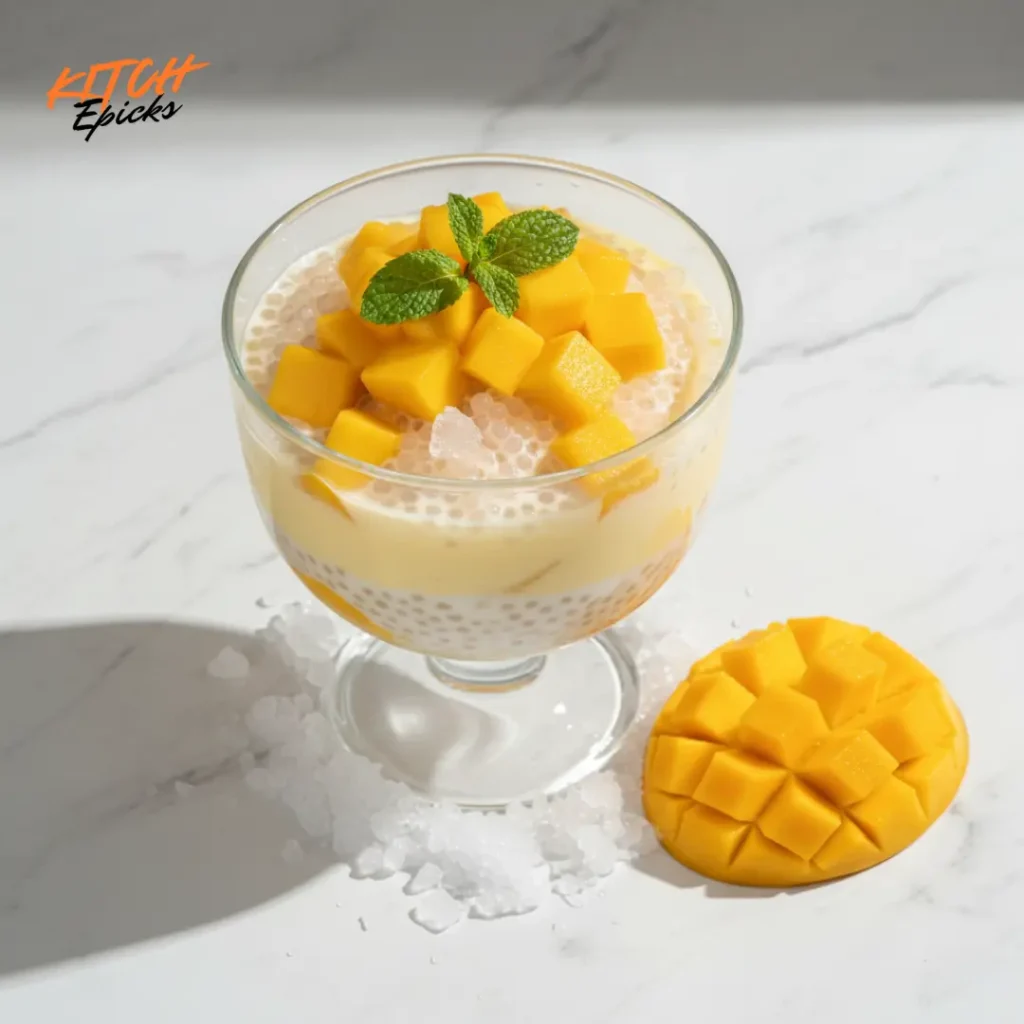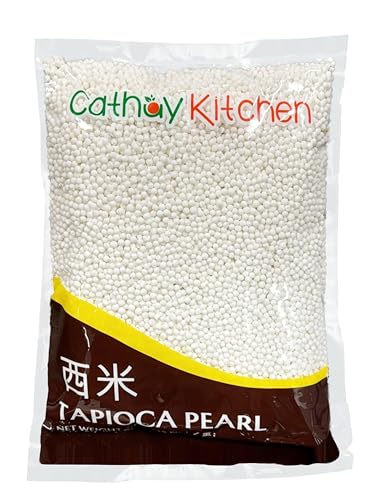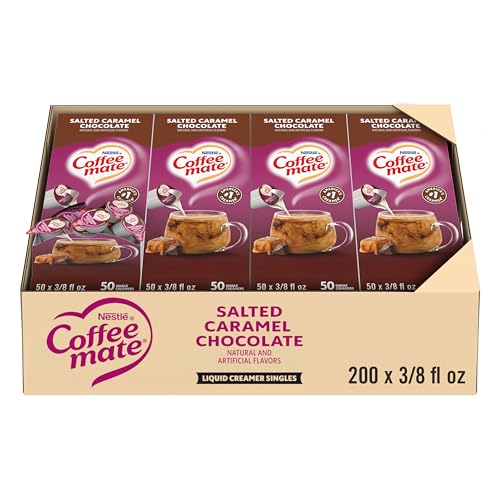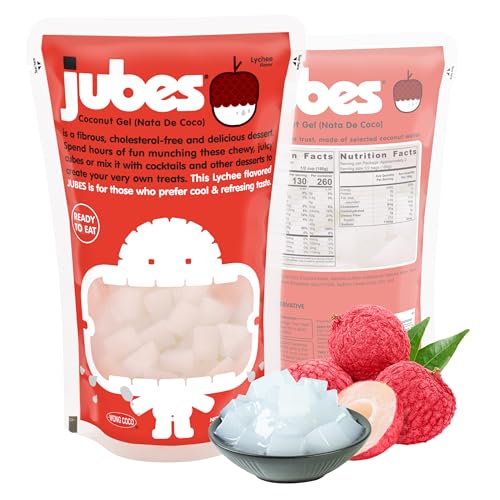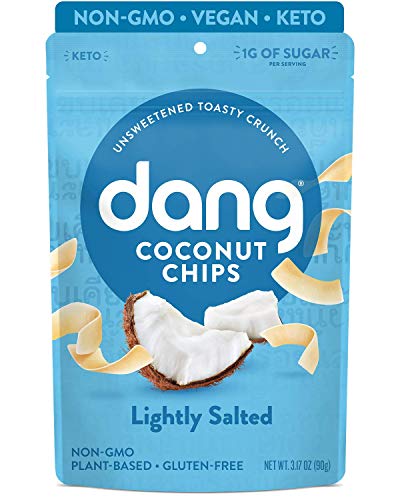Mango Sago
Prep Time: 15 minutes
Cook Time: 15 minutes
Chill Time: 30-60 minutes
Total Time: 1 hour
Servings: 4-6
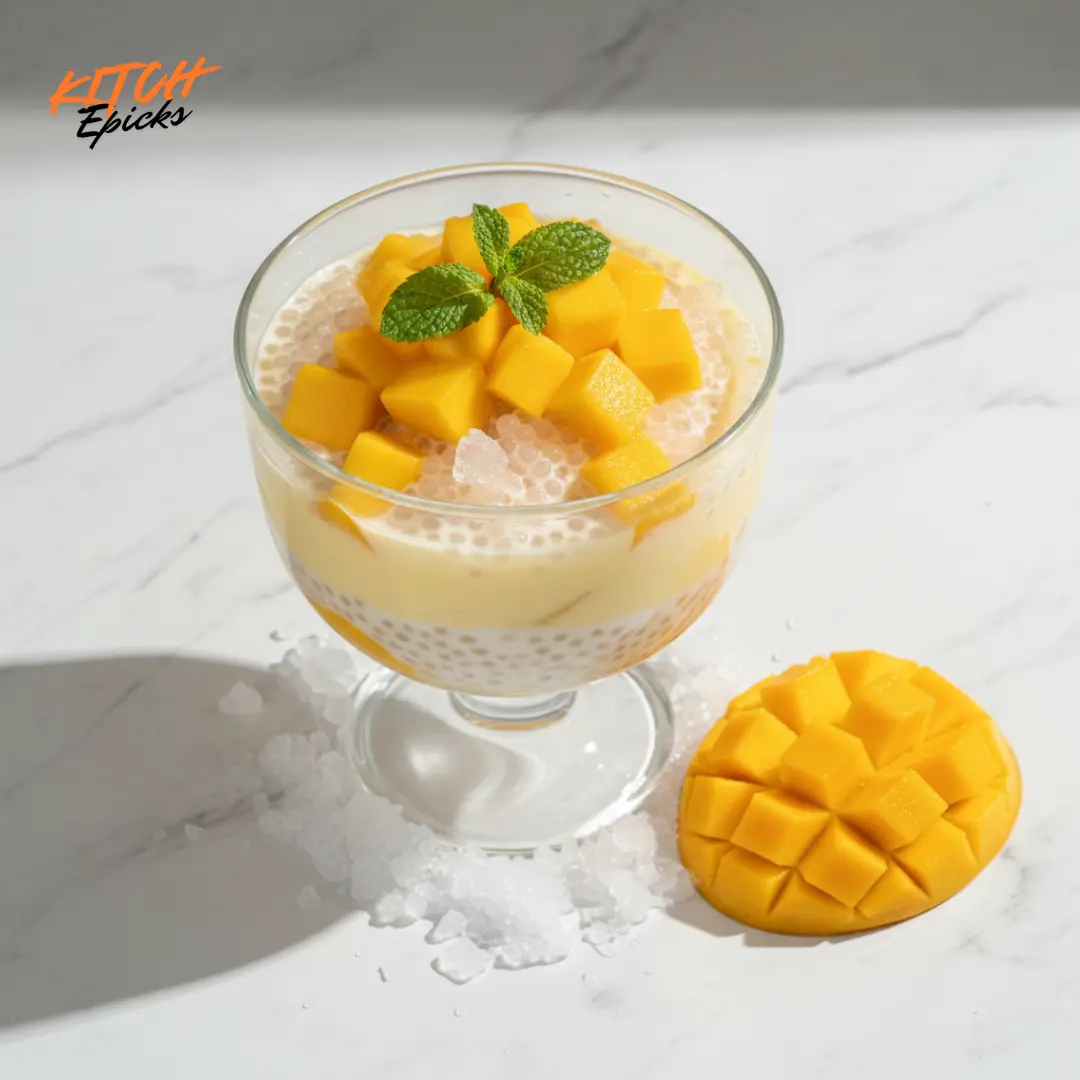
Creamy mango dessert with tapioca pearls that’s easy and affordable to make for everyone! This tropical Filipino-style treat combines sweet mango puree, coconut milk, and chewy sago for the perfect refreshing dessert.
Want to save this recipe?
Subscribe to get this recipe and more sent straight to your inbox!
Ingredients
- ½ cup small tapioca pearls (sago)
- 2-3 large ripe mangoes (about 2 pounds)
- 1 cup full-fat coconut milk
- ¼ cup sweetened condensed milk (adjust to taste)
- ½ cup whole milk or evaporated milk
- ½ tsp vanilla extract (optional)
- ½-1 cup coconut jelly (nata de coco), optional
- Crushed ice for serving (optional)
Instructions
- Cook Sago: Bring 4-5 cups water to boil in a medium pot. Add tapioca pearls and cook 10 minutes on medium heat, stirring occasionally. Turn off heat, cover, and let sit 10 minutes until fully translucent. Drain and rinse thoroughly under cold water.
- Make Mango Cream: Peel and dice mangoes. Reserve 1 cup diced mango for topping. Blend remaining mango with coconut milk, condensed milk, and vanilla extract until smooth in a high-powered blender.
- Assemble: In a large mixing bowl, combine cooked sago, mango cream, diced mango, and coconut jelly. Stir in additional milk to reach desired consistency.
- Chill and Serve: Refrigerate 30-60 minutes in covered container. Serve cold in glass dessert bowls over crushed ice.
Pro Tips
- Use ripe, fragrant mangoes for best flavor—underripe mangoes lack sweetness
- Rinse sago thoroughly to prevent gumminess and starch buildup
- Adjust sweetness based on mango ripeness before chilling
- Thin with extra milk if too thick after chilling
Nutrition Info
Serving Size: 1 serving (of 6)
Calories: 245
Carbohydrates: 48g
Protein: 3g
Fat: 8g
Fiber: 2g
Sugar: 35g
*Nutrition values are approximate and vary based on specific brands and ingredient substitutions used.
Craving something tropical, creamy, and ridiculously easy to make? Mango sago is your answer. This Filipino-style dessert combines chewy tapioca pearls, sweet mango puree, coconut milk, and chunks of fresh mango into a refreshing treat that disappears fast at any gathering. Whether you’re cooling off on a hot afternoon or need a stunning no-bake dessert for your next potluck—similar to our Classic Saltine Christmas Crack recipe—this mango sago recipe delivers restaurant-quality results using basic kitchen tools you already own.
At KitchePicks, we believe great recipes start with the right equipment. That’s why this guide doesn’t just teach you how to make mango sago—it connects each step to the kitchen tools that make the process faster, smoother, and more foolproof.
What Makes Mango Sago So Special
Mango sago originated from Hong Kong’s mango pomelo sago dessert but evolved into a simpler, more accessible version in Filipino kitchens. The dessert features translucent tapioca pearls swimming in a luscious coconut-mango base, topped with diced fresh mango and optional coconut jelly. It’s naturally gluten-free, can be made vegan, and requires zero baking—just like our popular Peppermint Chocolate Christmas Crack Recipe.
The magic happens when you blend ripe mangoes with coconut milk and condensed milk to create a creamy pudding base that’s sweet, tangy, and utterly addictive. The cooked sago adds textural contrast—each pearl is bouncy, slightly chewy, and fun to eat. Unlike heavy desserts, mango sago feels light and refreshing, making it perfect for summer entertaining or meal prep.
Essential Ingredients for Best Mango Sago Recipe
Core Ingredients
Small tapioca pearls (sago): Use ½ to ¾ cup of small pearl tapioca, which cooks faster than large boba pearls and turns translucent in 10-15 minutes. Look for white sago pearls in Asian grocery stores.
- 𝐒𝐌𝐀𝐋𝐋 𝐓𝐀𝐏𝐈𝐎𝐂𝐀 𝐏𝐄𝐀𝐑𝐋𝐒: A versatile kitchen staple, bring a world of culinary possibilities to your table. Its unique text…
- 𝐒𝐎𝐔𝐑𝐂𝐄 𝐎𝐅 𝐄𝐍𝐄𝐑𝐆𝐘 & 𝐄𝐀𝐒𝐘 𝐓𝐎 𝐃𝐈𝐆𝐄𝐒𝐓: Tapioca pearls are a rich source of carbohydrates, providing a quick and easily acces…
- 𝐏𝐑𝐄𝐌𝐈𝐔𝐌 𝐓𝐀𝐏𝐈𝐎𝐂𝐀 𝐏𝐄𝐀𝐑𝐋𝐒: Experience the epitome of tapioca excellence with our premium grade selection. Meticulously sour…
Ripe mangoes: You’ll need 2-4 large ripe mangoes depending on size. Filipino carabao mangoes or Mexican ataulfo varieties work beautifully for their sweetness and smooth texture.
Full-fat coconut milk: One 13.5-ounce can provides richness and tropical flavor. Light coconut milk works but produces a thinner consistency.
- Organic light coconut milk
- Reduced fat content
- Perfect for cooking and smoothies
Sweetened condensed milk: Start with ¼ cup and adjust to taste. This ingredient sweetens the dessert and adds creamy depth.
- Flavored Coffee Creamer: Nestle Coffee mate Salted Caramel Chocolate flavor coffee creamers add a swirl of rich and crea…
- Perfect for Here or On-the-Go: Stir our liquid creamer into a cup of coffee for a delicious flavor that’s lactose and ch…
- Delicious Flavor You Can Rely On: Shelf stable, no refrigeration needed, retain their delicious flavor at room temperatu…
Whole milk or evaporated milk: Some recipes use half-and-half or oat milk for extra creaminess.
Optional Mix-Ins
Coconut jelly (nata de coco): Adds extra chewiness and visual appeal.
- Juicy lychee coconut jelly – Ready-to-use coconut jelly cubes deliver a springy bite in fruit tea, milk tea, smoothies, …
- Precut cutting jelly convenience – Pour straight from the cup; ideal coconut jelly cubes for sago, panna cotta, parfaits…
- Boba bar friendly – Layer with coffee jelly, grass jelly, pandan jelly, aiyu jelly, or rainbow builds for café-style col…
Vanilla extract: ½ teaspoon enhances the overall flavor.
Crushed ice: Serve over ice for an ultra-refreshing presentation.
Kitchen Tools You’ll Need
A medium pot for boiling sago, a high-powered blender for the mango puree, a fine-mesh strainer for rinsing pearls, and mixing bowls for assembly. Having a quality blender makes the mango cream silky smooth—check our reviews of the best blenders for dessert making.
Step-by-Step Mango Sago Dessert Recipe
Prep the Tapioca Pearls
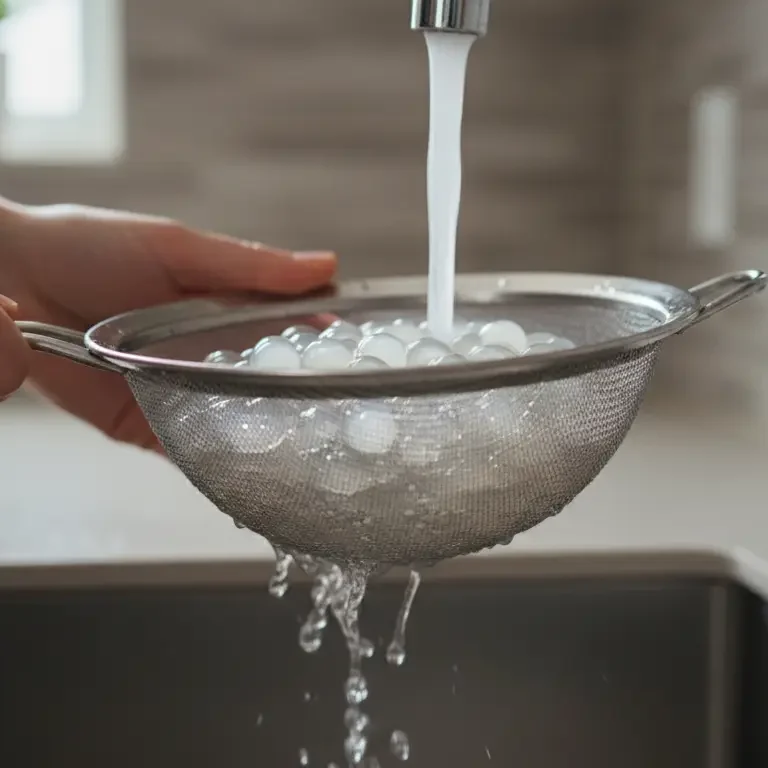
Bring a large pot of water (4-5 cups) to a rolling boil over high heat. Add ½ to ¾ cup of small tapioca pearls and stir immediately to prevent clumping. Reduce heat to medium and cook uncovered for 10 minutes, stirring occasionally. The pearls should turn from white to mostly translucent with a small white dot in the center.
Turn off the heat, cover the pot with a lid, and let the sago sit for another 10 minutes until fully translucent. This resting period ensures the pearls cook through without becoming mushy. Drain the cooked sago through a fine-mesh strainer and rinse thoroughly under cold running water to stop the cooking process and remove excess starch. Keep the pearls submerged in cold water until assembly.
Make the Mango Coconut Cream
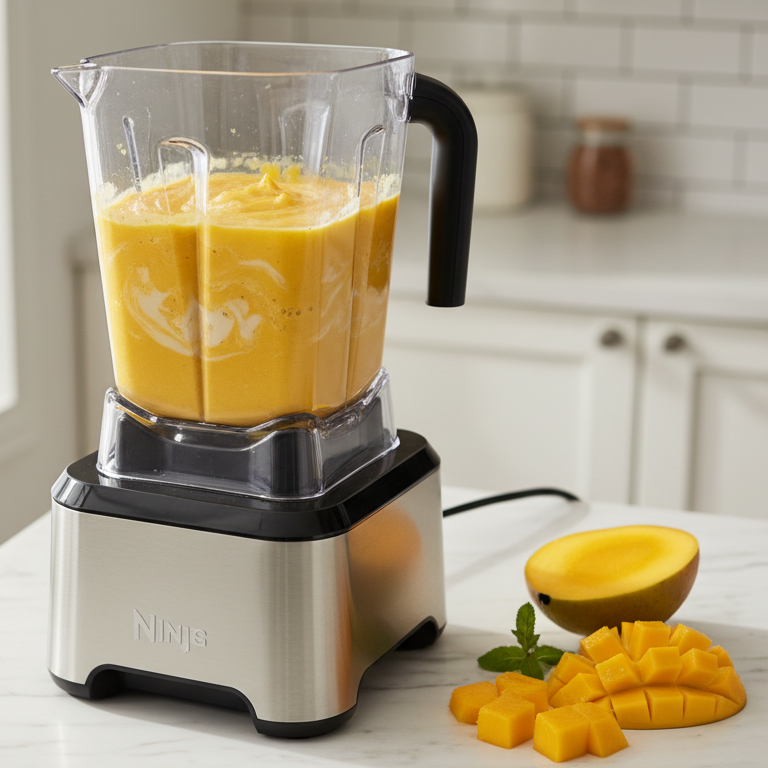
Peel and dice your mangoes, setting aside about 1 cup of diced mango chunks for topping. Add the remaining mango flesh (about 1-2 pounds) to a high-powered blender along with 1 cup full-fat coconut milk and ¼ cup sweetened condensed milk. Blend on high speed until completely smooth and creamy with no lumps.
Taste the mango mixture and adjust sweetness as needed—if your mangoes are super ripe and sweet, you may not need additional condensed milk. For less sweet mangoes, add 1-2 more tablespoons of condensed milk. Optional: stir in ½ teaspoon vanilla extract for extra depth.
Assemble Your Mango and Sago Dessert
Drain the cooked tapioca pearls completely, shaking out excess water. In a large mixing bowl or individual serving glasses, combine the drained sago, mango coconut cream, diced mango chunks, and coconut jelly if using. Stir gently to distribute all ingredients evenly.
Pour in additional whole milk, coconut milk, or half-and-half to reach your desired consistency—some prefer it thick like pudding while others like it soupy. Cover and refrigerate for at least 30-60 minutes to chill thoroughly. Serve cold over crushed ice for maximum refreshment.
- INCLUDES: This glass dessert set contains (1) 3-quart footed glass bowl. Serve fruits, desserts, trifles, puddings, tira…
- USE: Unlike most trifle bowls, this look avoids overly ornate designs in favor of the refinement, and versatility, of si…
- DURABLE: This trifle serving bowl is a mix of durable glass and expert style. Dishwasher and refrigerator safe. Thick wa…
Pro Tips for Perfect Mango Sago Recipe with Coconut Milk
Selecting the Best Mangoes
Choose mangoes that yield slightly to gentle pressure and smell fragrant at the stem end. Avoid hard, unripe mangoes or overripe ones with dark spots. For the sweetest results, let mangoes ripen at room temperature until they’re soft and aromatic. This attention to ingredient quality matters in desserts just as much as in savory dishes like our Japanese Mounjaro Recipe: 5 Facts You Need to Know (2025).
Cooking Sago Perfectly
Different brands of tapioca pearls require different cooking times—always check package instructions first. The key is watching for the pearls to turn from opaque white to mostly clear. Never skip the rinsing step, as it removes excess starch that makes the dessert gummy. Use a pot with plenty of water (at least 4 cups per ½ cup sago) to give pearls room to expand.
Texture and Consistency
For a thicker, pudding-like consistency, use less milk and more mango puree. For a lighter, soup-style dessert, thin it out with extra coconut milk or whole milk. Some cooks prefer blending only half the mango for texture while keeping the other half in chunks.
Kitchen Tools That Make a Difference
A fine-mesh strainer prevents sago from slipping through and rinses pearls efficiently. A high-powered blender creates the smoothest mango cream—stick blenders work but may leave fibrous bits. Glass serving bowls or dessert cups showcase the beautiful layers of mango and pearls. Learn more about choosing the right kitchen tools from Serious Eats’ equipment testing methodology.
- AIRTIGHT LIDS & 3 GRATER ATTACHMENTS:The airtight lids that come with this mixing bowl set make it easy to store ingredi…
- NON-SLIP SILICONE BOTTOMS: The rubber on the bottom of the mixing bowls is for gripping and staying put which prevents s…
- NESTING BOWLS & DISHWASHER SAFE: These kitchen serving bowls can be nested together and offer space-efficient storage in…
Common Mistakes to Avoid
Overcooking the Tapioca
Cooking sago too long creates mushy pearls that dissolve into the cream. Watch closely during the final 5 minutes and check for translucency. If pearls still have a white center after the resting period, cover and let sit 2-3 more minutes rather than boiling longer.
Using Underripe Mangoes
Hard, sour mangoes ruin the dessert and require excessive added sugar. Wait until mangoes are fully ripe—they should smell sweet and feel slightly soft. If mangoes aren’t sweet enough, increase condensed milk by tablespoons rather than cups to avoid masking mango flavor.
Skipping the Rinse
Unwashed sago releases starch that makes the entire dessert gluey and cloudy. Always rinse pearls under cold running water in a fine-mesh strainer immediately after draining. This simple step keeps pearls separate and bouncy.
Wrong Milk Choice
Low-fat or skim milk produces a watery, less satisfying dessert. Stick with full-fat coconut milk and whole milk or evaporated milk for richness. Light coconut milk can work if you compensate with cream or condensed milk.
Recipe Variations and Customizations
Filipino-Style Mango Sago
The classic Filipino version skips pomelo and focuses on pure mango flavor with evaporated milk and sweetened cream. Some recipes incorporate custard powder mixed with milk for extra richness and a pudding-like texture. Top with chopped peanuts or toasted coconut for crunch—similar to how we finish our The BEST Almond Toffee Crack (Easy Christmas Crack) with toasted nuts.
- We harvest mature Thai coconuts, slice up the coconut meat, and toast it to perfection using a recipe that’s true to our…
- We use simple, healthy ingredients that are keto certified, paleo friendly, non GMO, gluten free, 100% plant based, vega…
- Guilt-free vegan food with 1g of sugar per serving. Enjoy straight from the bag, or up your topping game and add a satis…
Mango Pomelo Sago Recipe
Add segmented pomelo (grapefruit works too) along with mango for the Hong Kong-style original. The citrus adds tartness that balances the sweet mango and creamy coconut. This version often includes evaporated milk drizzled on top.
Vegan Mango Sago
Replace condensed milk with maple syrup, agave, or additional coconut milk sweetened with coconut sugar. Use full-fat canned coconut milk and oat milk or soy milk as the base. The result is equally creamy and completely plant-based.
- 100% PURE MAPLE SYRUP
- MADE IN CANADA
- You get (2) 540ml/18.26 oz., Cans
Mango Sago Recipe Philippines Style
Some Filipino cooks add sabja seeds (basil seeds) for extra texture alongside the sago. Others incorporate sweetened cream (Nestle Cream) instead of condensed milk for a richer, thicker consistency. Serve in tall glasses with long spoons for a cafe-style presentation.
Best Kitchen Tools for Making Mango Sago Recipes
Blenders
A high-powered blender like a Vitamix or Ninja creates perfectly smooth mango puree with no chunks. For occasional dessert making, a mid-range immersion blender works but requires longer blending time. According to America’s Test Kitchen equipment reviews, investing in quality blending equipment transforms your dessert-making capabilities.
Pots and Strainers
Use a medium-sized pot (at least 3-quart capacity) with a heavy bottom to prevent scorching. A fine-mesh strainer is essential—look for one with small holes that catch even tiny sago pearls. Stainless steel strainers last longer than silicone versions and handle hot water better.
- 𝐄𝐧𝐣𝐨𝐲 𝐄𝐟𝐟𝐨𝐫𝐭𝐥𝐞𝐬𝐬 𝐂𝐨𝐨𝐤𝐢𝐧𝐠: Experience easy food release and cleanup thanks to our ProGlide Non-Stick interior. Cook with …
- 𝐀𝐥𝐥 𝐘𝐨𝐮 𝐍𝐞𝐞𝐝: Our 3 quart covered saucepan is handy for cooking various dishes such as sauces, soups, boiling vegetables…
- 𝐓𝐡𝐞𝐫𝐦𝐨-𝐒𝐩𝐨𝐭 𝐓𝐞𝐜𝐡𝐧𝐨𝐥𝐨𝐠𝐲: Our unique heat indicator turns solid red when the pans are properly pre-heated. Additionally, t…
Serving and Storage
Glass dessert bowls or mason jars let you see the beautiful layers of mango cream and pearls. For parties, portion individual servings ahead of time in clear cups. Store leftovers in airtight containers—glass or BPA-free plastic work equally well. A good set of measuring cups and spoons ensures consistent sweetness every time.
Storing and Serving Tips
Mango sago tastes best when served cold, ideally within 24 hours of making. Store in an airtight container in the refrigerator for up to 2-3 days. The tapioca pearls may absorb liquid over time, so thin with extra coconut milk or whole milk before serving leftovers. Do not freeze mango sago—the texture of both the pearls and mango chunks deteriorates significantly.
For entertaining, prepare the sago and mango cream separately up to 1 day ahead, then combine just before serving to maintain the best texture. Keep diced mango refrigerated in a sealed container with a squeeze of lemon juice to prevent browning. Serve in chilled bowls or glasses over crushed ice for maximum refreshment.
This make-ahead approach works beautifully for parties, similar to how our Peppermint Chocolate Christmas Crack Recipe can be prepared days in advance for holiday gatherings.
Why This Recipe Works
The combination of textures—creamy coconut mango base, chewy tapioca pearls, and juicy mango chunks—creates a dessert that’s fun to eat and deeply satisfying. The natural sweetness of ripe mangoes means you can control sugar levels better than store-bought desserts. Coconut milk adds tropical richness without dairy, making it naturally lactose-friendly when you skip condensed milk.
From a kitchen efficiency perspective, mango sago requires minimal active cooking time—just 10 minutes of boiling sago—while the rest is simple blending and mixing. No oven, no tempering, no complicated techniques. This makes it perfect for beginners and experienced cooks alike who want impressive results without fuss.
The recipe is also highly adaptable to what you have on hand—swap milk types, adjust sweetness, add different fruits. Because it scales easily, you can make a small batch for two or a large bowl for a crowd. For more no-bake dessert inspiration, check out our Classic Saltine Christmas Crack recipe.
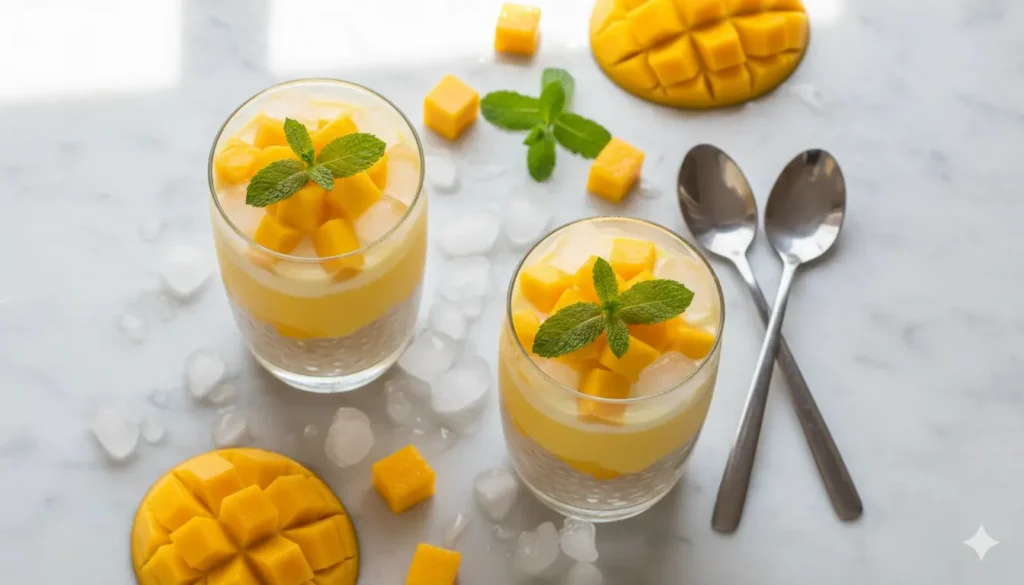
Recipe Card
Prep Time: 15 minutes
Cook Time: 15 minutes
Chill Time: 30-60 minutes
Total Time: 1 hour
Servings: 4-6 servings
Cuisine: Filipino, Asian
Difficulty: Easy
Key Tools: Medium pot, blender, fine-mesh strainer
Ingredients
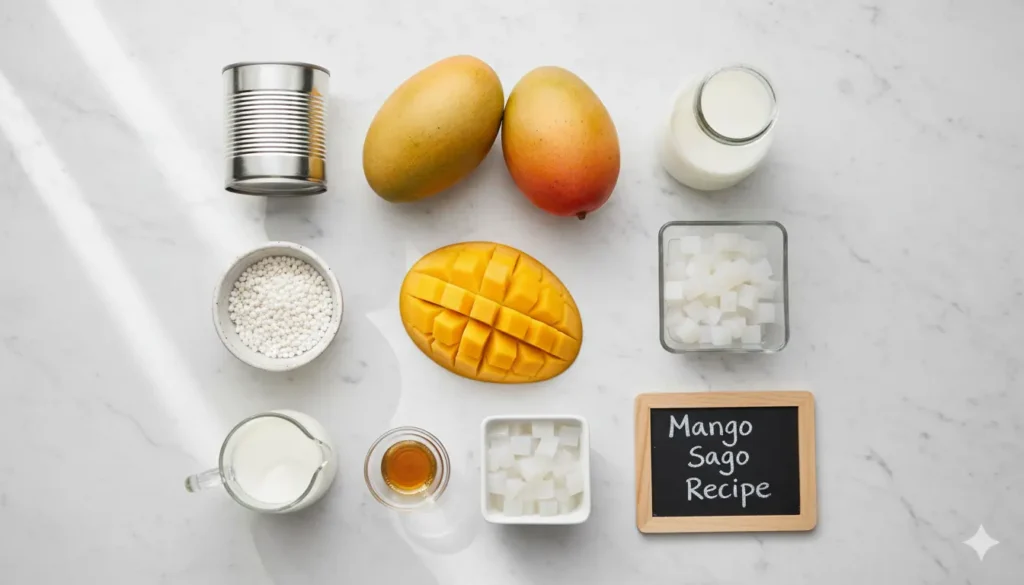
- ½ cup small tapioca pearls (sago)
- 2-3 large ripe mangoes (about 2 pounds)
- 1 cup full-fat coconut milk
- ¼ cup sweetened condensed milk (adjust to taste)
- ½ cup whole milk or evaporated milk
- ½ tsp vanilla extract (optional)
- ½-1 cup coconut jelly (nata de coco), optional
- Crushed ice for serving (optional)
Instructions
- Cook Sago: Bring 4-5 cups water to boil in a medium pot. Add tapioca pearls and cook 10 minutes on medium heat, stirring occasionally. Turn off heat, cover, and let sit 10 minutes until fully translucent. Drain and rinse thoroughly under cold water.
- Make Mango Cream: Peel and dice mangoes. Reserve 1 cup diced mango for topping. Blend remaining mango with coconut milk, condensed milk, and vanilla extract until smooth in a high-powered blender.
- Assemble: In a large mixing bowl, combine cooked sago, mango cream, diced mango, and coconut jelly. Stir in additional milk to reach desired consistency.
- Chill and Serve: Refrigerate 30-60 minutes in covered container. Serve cold in glass dessert bowls over crushed ice.
Pro Tips
- Use ripe, fragrant mangoes for best flavor—underripe mangoes lack sweetness
- Rinse sago thoroughly to prevent gumminess and starch buildup
- Adjust sweetness based on mango ripeness before chilling
- Thin with extra milk if too thick after chilling
Nutrition Information (per serving, approximate)
- Calories: 245
- Carbohydrates: 48g
- Protein: 3g
- Fat: 8g
- Fiber: 2g
- Sugar: 35g
Note: Nutrition values vary based on specific brands and ingredient substitutions used.
More No-Bake Dessert Recipes You’ll Love
If you enjoyed this mango sago recipe, you’ll definitely want to try these other crowd-pleasing no-bake desserts from KitchePicks:
- The BEST Almond Toffee Crack (Easy Christmas Crack) – A crunchy, buttery toffee dessert that requires zero baking skills and disappears in minutes at parties.
- Classic Saltine Christmas Crack recipe – The iconic sweet-and-salty treat that’s perfect for holiday gifting and year-round snacking.
- Peppermint Chocolate Christmas Crack Recipe – A festive twist on the classic with refreshing peppermint and rich chocolate layers.
- Japanese Mounjaro Recipe: 5 Facts You Need to Know (2025) – Explore authentic Japanese cooking with this comprehensive guide to traditional techniques and ingredients.
For more recipe inspiration and kitchen equipment reviews, explore our complete recipe collection and equipment testing guides.
Final Thoughts
Mango sago represents everything we love about simple, crowd-pleasing desserts: minimal ingredients, straightforward techniques, and spectacular results. The combination of creamy mango puree, chewy tapioca pearls, and coconut milk creates a tropical dessert that feels special without requiring advanced cooking skills or specialized equipment.
Whether you’re new to Filipino desserts or looking to expand your no-bake recipe repertoire, this mango sago recipe delivers consistent, delicious results every time. The recipe scales beautifully for intimate dinners or large gatherings, stores well for make-ahead convenience, and adapts easily to dietary preferences including vegan and dairy-free options.
Ready to make this restaurant-quality dessert at home? Gather your ingredients, pull out your blender and strainer, and get ready to impress your family and friends with this irresistible tropical treat. Don’t forget to share your mango sago creations with us in the comments below!
Frequently Asked Questions
What is sago and where can I buy it?
Sago refers to small tapioca pearls made from cassava starch that turn translucent when cooked. You can find them in Asian grocery stores or online, labeled as “small pearl tapioca” or “sago.” They’re different from large boba pearls used in bubble tea—look for pearls about 2-3mm in diameter.
Can I make mango sago ahead of time?
Yes, mango sago keeps well in the refrigerator for 2-3 days in an airtight container. The tapioca pearls may absorb liquid over time, so add extra coconut milk or whole milk before serving leftovers. For best texture, combine the components within a few hours of serving rather than days in advance.
What can I substitute for coconut milk in mango sago?
Replace coconut milk with evaporated milk, whole milk, half-and-half, or even oat milk for a different flavor profile. Filipino-style mango sago often uses evaporated milk and sweetened cream instead of coconut milk. Keep in mind that coconut milk provides tropical flavor and richness that other milks don’t match.
How do I know when sago pearls are properly cooked?
Properly cooked sago pearls should be completely translucent with no white center remaining. They should feel bouncy and slightly chewy when bitten, not mushy or hard. If you see a small white dot in the center after cooking, cover the pot and let them rest for 2-3 more minutes off the heat.
Can I use frozen mango instead of fresh?
Yes, frozen mango works well as a substitute, especially when fresh ripe mangoes aren’t available. Thaw the frozen mango completely and drain excess liquid before blending. Frozen mango may be slightly less sweet than fresh, so taste and adjust condensed milk accordingly.
Is mango sago gluten-free?
Yes, mango sago is naturally gluten-free when made with traditional tapioca pearls, coconut milk, and fresh fruit. Always verify that your specific brand of tapioca pearls and condensed milk are certified gluten-free if you have celiac disease or severe gluten sensitivity.

